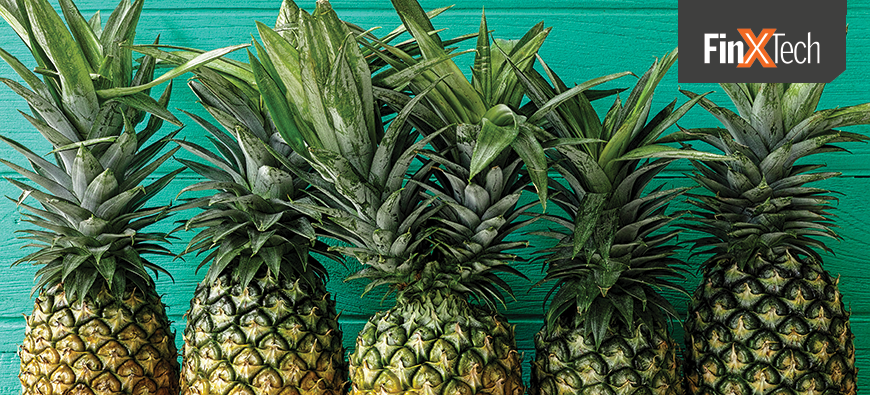
Power in Pineapples: Why Less Isn’t More in Financial Education
One of the first things we’re taught about money is that it is imperative to save it. But that is often where the lesson ends.
What type of loans should students take out? When is the best time to start investing? Should we invest and where? Where should we go in a financial emergency?
For a society that prides itself on its economy, most of its citizens are lacking the basic knowledge of how its primary building block – money – works. The 2021 TIAA Institute GFLEC Personal Finance Index, which measures working financial knowledge in adults 18 years and older, found that, on average, respondents were only able to answer half of its questions accurately. The disparities were great between race and ethnic groups. While 55% of non-Hispanic white respondents answered its index questions correctly, Hispanic and Black Americans scored 41%, and 37%, respectfully.
On top of that, debt is soaring. Experian found that overall consumer debt hit an all-time high of $14.88 trillion in 2020. Student loan debt accounted for over $1.5 trillion, auto loan debt reached $1.35 trillion and mortgage debt climbed to an astounding $10.3 trillion. Federal student loan payments, which were suspended during the pandemic, resume October 1, putting more pressure on student borrowers in the months ahead.
Banks have long offered personal finance education in local schools and through partnerships with various nonprofits. Transitioning into the digital age, many of them also offer budgeting and money management apps. Even so, consumers may not be thrilled with what banks have to offer. A February 2021 study from the Ipsos-Forbes Advisor U.S. Consumer Confidence Tracker found that only 5% of respondents ranked their bank’s budgeting and tracking tools as one of its top three most valuable mobile features. Mobile check deposit, viewing statements and account balances and transferring funds between accounts took the top three spots.
Ready to go to work on this issue is Bolun Li, one of the founders and CEO of Durham, North Carolina-based Zogo Finance, an emerging trailblazer in the financial literacy fintech sector. Zogo aims to keep financial education sourced at a consumer’s primary financial institution. Banks can white-label Zogo’s gamified app, can use it to teach customers about general financial topics as well as bank-specific product offerings, and track usage and engagement.
While Zogo was created with the Gen-Z and Millennials in mind, it claims users of all ages, backgrounds and demographics. If a bank has the app, any of its customers can access it.
“Too few students – particularly those from low-income backgrounds – receive any personal finance education during their K-12 years,” says Li. “Even existing financial education initiatives, where they exist, often overlook the learning preferences and needs of younger generations. In many instances, these offerings are boring, complex, and intimidating.”
A Council for Economic Education report last year found only 21 states require high school students to take a class in personal finance.
Li says: “Upon reaching adulthood, however, people are confronted with an array of major financial decisions regarding student debt, credit cards, housing, car ownership, retirement planning and taxes.”
Black Americans in particular have a disadvantage when it comes to financial wellness. But Kevin Cohee, chairman, CEO and owner of Boston-based, black-owned and fully digital OneUnited Bank, with $653 million in assets as of March, views digital solutions as a way to start empowering consumers. “This online banking product [digital banking platforms] allows for a broader base of communication that can be used for things like teaching financial literacy,” he told Forbes earlier this year.
OneUnited Bank pioneered OneTransaction Conference, a free and virtual financial conference, on Juneteenth (June 19) of this year, capitalizing on the community’s need for better and equalized access to financial education resources. The event had over 25,000 participants sign up.
What seems clear is that this type of financial education must increasingly be delivered through online or mobile channels for today’s consumers. With digital solutions like Zogo, users can access hundreds of lessons at any time, anywhere. Users accumulate pineapples – selected as the app’s gamified coin due to the fruit’s popularity – as they learn. The fintech further sweetens the pot by rewarding users for completing learning milestones, with options such as gift cards and bank-specific products and discounts.
Zogo understands what consumers want: access to everything online, incentives and bite-sized bits of knowledge.
In a June article detailing where banks have traditionally fallen short in providing financial health resources to its consumers, former bank executive Evan Siegel writes, “Navigating the journey [of personal finance management] requires a series of personalized, bite-sized action plans. The advice must be delivered in discrete chunks, so as not to overwhelm, and served up as an ongoing diet because financial improvement requires many actions.” If not, the knowledge won’t stick, and consumers can quickly get overwhelmed.
Zogo, coming off of signing its 100th financial institution, was asked what types of lessons and categories its users were flocking to. It doesn’t concern federal aid, mortgages or even cryptocurrency.
It’s investing.
“We’re seeing young people really gravitate towards our ‘Start Investing’ and ‘Save Money’ categories,” Li says. “Their behavior in the app has suggested people are really hungry for investing education – so much so that we released another category in the app called ‘Advanced Investing.’ Older people, on the other hand, tend to gravitate towards our ‘Save for Retirement’ category.”
Li wants Zogo to put banks and credit unions in a better position to tackle America’s financial illiteracy problem, one pineapple at a time.



